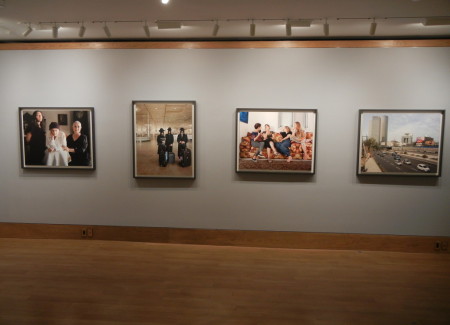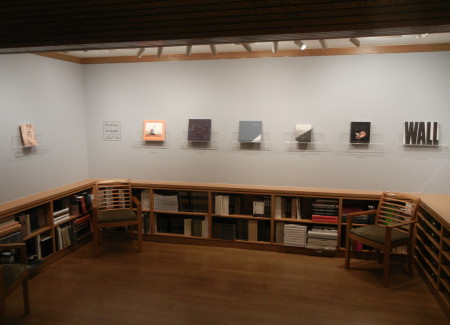JTF (just the facts): A total of 17 large scale color photographs (14 single images and 1 triptych), framed in dark grey and unmatted, and hung against grey walls in the main gallery space and one of the side viewing rooms. All of the works are archival pigment prints, made between 2009 and 2013 and printed in 2015. Physical sizes are either 30×40 (in editions of 12) or 40×50 or reverse (in editions of 8); the triptych panels are roughly 23×29 each (in editions of 12). A monograph of this body of work was published in 2014 by MACK Books (here). (Installation shots below.)
Selections from Brenner’s previous bodies of work in black and white, Diaspora and Exile at Home, are on view in the second gallery space and the smaller back gallery.
In the book alcove, all of the books from the larger project This Place are on display. These books were made by Wendy Ewald, Martin Kollar, Jodef Koudelka, Jungjin Lee, Gilles Peress, Fazal Sheikh, Stephen Shore, Rosalind Solomon, Thomas Struth, Jeff Wall, Nick Waplington, and Brenner. A website for the project can be found here; a summary publication/catalog was released by MACK Books in 2014 (here).
Comments/Context: From dangerous expeditionary projects to more mundane Grand Tour views, the urge to use photography to try to understand a foreign culture traces its roots all the way back to the very beginnings of the medium. And while natives and insiders have long been able to incisively see the nuances of their own complex cultures (think Sander in Germany, Atget in France, or Goldblatt in South Africa), outsiders have had some surprising successes in bringing fresh eyes to established national narratives. Weston in Mexico, Evans in Cuba, and most notably Frank all across America – these greats were all able to find their own unique approaches to capturing the spirit of a foreign place, often uncovering subtleties that were largely overlooked by the locals.
Frédéric Brenner’s ambitious new project multiplies this outsider approach, turning the cameras of no less than dozen acclaimed photographers (from Struth and Wall to Shore and Koudelka, and many others, including himself) on contemporary Israel. In many ways, This Place (as the larger project is called) replicates the loose teamwork approach of the Farm Security Administration of the 1930s – sending diversely talented photographers out to investigate different facets of a bigger story, with the hope that the resulting overlaps and connections just might generate a multi-layered picture of the complexities taking place.
Aside from a growing gathering of the books made by the other contributors, this show focuses on Brenner’s own contributions to the project, in the form of an elegantly tense body of work entitled An Archeology of Fear and Desire. Executed in large format color, the pictures turn landscapes and portraits into carefully composed tableaux, each one a moment of enigmatic contrasts and symbolism. His images depict an Israel quietly balancing the weight of history and the challenges of the modern present, mixing the hardness of the land with the tenderness of family.
Brenner’s land and cityscapes are full of pregnant tension – not the easy going irony of contrasts, but more a tautness of readily observed, overt conflict, in varying degrees of harshness and beauty. A children’s sandlot game is interrupted by the white blocks of bomb shelters, while the Palace Hotel is like a worn out husk, the shell of the building being reclaimed by new construction inside. A triumphantly stubborn tree blooms amid the broken rubble it has broken through, while motorists stand in silence on the expressway, observing some unexplained ritual in the midst of the bustle of the city.
This theme of willful perseverance in the face of surroundings that refuse to cooperate comes through even stronger in Brenner’s many powerful portraits. Families cluster tenuously amid the dry rocky hills or under the punishing sun of an unidentified sandy expanse (the beach, the roadside, the desert?), as equally ill at ease and vulnerable as the veiled Orthodox men in the airport and the gay couple posing amid the thorny cacti. Multi-generational gatherings are steeped in cultural history, backgrounded by paintings of elders and furniture and silver passed down through the years; they point to a reliance on tradition and ritual to hold families together. Only amid the soothing waters of a stream or the comforting presence of close friends does a sense of casual warmth emerge, where group storytelling reinforces common bonds and connections.
Given Brenner’s decades of experience documenting the lives of Jewish families around the world, it is not altogether unexpected that he would be well attuned to seeing Israel with such thoughtfulness. Each picture in this show is like a self contained meditation on the inherent dilemmas of the nation. He’s found the richness in its many contradictions, and embraced them with searching sensitivity.
Collector’s POV: The works in this show are priced as follows. The 30×40 prints are $14500 each, while the 40×50 prints are $27000 each; the triptych is $15000. Brenner’s work has little consistent secondary market history, so gallery retail likely remains the best option for those collectors interested in following up.










